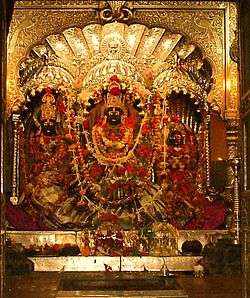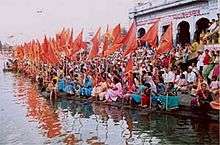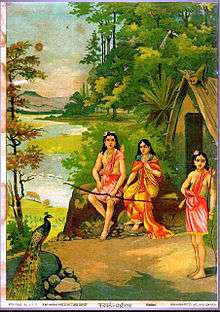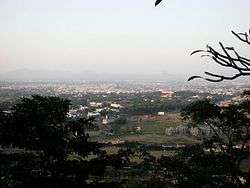Nashik
| Nashik नाशिक Nasik | |
|---|---|
| Metropolis | |
|
Nashik city view from Pandavleni | |
 Nashik Location of Nashik in Maharashtra | |
| Coordinates: 20°00′N 73°47′E / 20.00°N 73.78°ECoordinates: 20°00′N 73°47′E / 20.00°N 73.78°E | |
| Country |
|
| State | Maharashtra |
| District | Nashik |
| Named for | Historical Places |
| Government | |
| • Type | Mayor–Council |
| • Mayor | Ashok Murtadak (MNS) |
| • Municipal Commissioner | Mr.Abishekh Krishna |
| • Deputy Mayor | Gurmeet Bagga (Independent) |
| • Member Of Parliament | Hemant Godse (Shivsena) |
| Area | |
| • Metropolis | 300 km2 (100 sq mi) |
| Elevation | 700 m (2,300 ft) |
| Population (2011)[1] | |
| • Metropolis | 1,862,769 |
| • Density | 6,200/km2 (16,000/sq mi) |
| • Metro[2] | 4,862,769 |
| • Metro rank | 29th |
| Demonym(s) | Nashikkar |
| Language | |
| • Official | Marathi |
| Time zone | IST (UTC+5:30) |
| PIN | 422 0xx |
| Telephone code | 91(253) |
| Vehicle registration | MH 15 |
| Website |
www |
Nashik (pron:ˈnʌʃɪk) (![]() pronunciation )[3] is a city in the northwest region of Maharashtra in India, and is the administrative headquarter of the Nashik District and Nashik Division.
pronunciation )[3] is a city in the northwest region of Maharashtra in India, and is the administrative headquarter of the Nashik District and Nashik Division.
The city is situated at the foothills of the Western Ghats mountains on the banks of the river Godavari. At 700 m (2,300 ft) above sea level, its elevation is highest among the major cities in Maharashtra and one of the highest among million plus cities in India.[4]


Geography
Nashik is in northern Maharashtra at 700 m (2,300 ft)[5] from the mean sea level. The river Godavari originates 24 km (15 mi) from Brahmagiri Mountain, Trimbakeshwar, Nashik and flows along the northern boundary of the city through the old residential settlement. The river had been dying at an alarming rate due to pollution created by factories. But it has been successfully cleaned.[6] Other than Godavari, important rivers like Vaitarana, Bhima, Girana, Kashyapi and Darana flow across Nashik.[7]
Nashik lies on the western edge of the Deccan Plateau which is a volcanic formation.[8] All over the district, lime nodules and kankar are found. Jalgaon and Aurangabad are to the east of Nashik. Ahmadnagar lies to the south while Thane and part of Gujrat are to the west of Nashik.[9]
Trimbakeshwar is about 30 km (19 mi) from the city, it is where from river Godavari originates. The land area of the city is about 259.13 km2 (100.05 sq mi).[10]
Climate
The city's tropical location and high altitude combine to give it a relatively mild version of a tropical wet and dry climate. Summers, which last from March to mid-June, are hot, with maximum temperatures reaching 36 °C, but are extremely dry. They are followed by the monsoon season, which continues till early October. These months see high levels of cloud cover, torrential rains, and flooding. Temperatures rise slightly in October, but this is followed by the cool season from November to February. The cool season sees warm temperatures of around 28 °C during the day, but cool nights, with lows averaging 13 °C, and extremely dry air.
| Climate data for Nashik | |||||||||||||
|---|---|---|---|---|---|---|---|---|---|---|---|---|---|
| Month | Jan | Feb | Mar | Apr | May | Jun | Jul | Aug | Sep | Oct | Nov | Dec | Year |
| Average high °C (°F) | 28.3 (82.9) |
30.1 (86.2) |
33.3 (91.9) |
35.5 (95.9) |
35.9 (96.6) |
32.1 (89.8) |
28.2 (82.8) |
28.0 (82.4) |
28.6 (83.5) |
30.9 (87.6) |
29.9 (85.8) |
28.7 (83.7) |
30.79 (87.43) |
| Average low °C (°F) | 12.5 (54.5) |
13.6 (56.5) |
17.4 (63.3) |
21.1 (70) |
23.2 (73.8) |
23.1 (73.6) |
22.0 (71.6) |
21.5 (70.7) |
20.7 (69.3) |
19.2 (66.6) |
15.5 (59.9) |
12.9 (55.2) |
18.56 (65.42) |
| Average precipitation mm (inches) | 1.0 (0.039) |
0.0 (0) |
2.0 (0.079) |
7.0 (0.276) |
17.0 (0.669) |
112.0 (4.409) |
248.0 (9.764) |
163.0 (6.417) |
169.0 (6.654) |
69.0 (2.717) |
20.0 (0.787) |
4.0 (0.157) |
812 (31.968) |
| Source: Climate data | |||||||||||||
Civic administration
Nashik city is governed by the Nashik Municipal Corporation.[11]
Court
The Nashik Court Building is built in black stone in British Regime and the new building was inaugurated on 18 September 2005. There are 73 courts including taluka court.[12][13]
Solid waste management
In the Nashik Municipal Corporation area about 225 MT of solid waste is generated per day. Unlike other Indian cities, this garbage is collected by vehicles titled 'Ghantagadi' (meaning the vehicle with a bell): a system which has resulted in a 'garbage dump free' city. Smaller versions of the ghantagadi ply in the congested old city areas. A plant has been set by the Nashik Municipal Corporation near Pandav Leni (Pandavleni Caves) to process the garbage and convert into compost.[14]
Demographics
According to the Census of India, 2011, Nashik had a population of 14,86,973. Males constitute 7,84,995 of the population and females 7,01,978. Out of Nashik urban population is 15,62,769 in which 8,24,641 are males and 7,38,128 are females. Nashik city had an average literacy rate of 90.96%: male literacy was 94.96%, and female literacy was 86.51%.
The sex ratio is 894 per 1000 males for Nashik city. Child sex ratio is 865 girls per 1000 boys. In Nashik, 11.42% of the population is under 6 years of age.[15] In census year 2001 the Nashik Urban Agglomeration had a population of 11,52,326. Thus it was the fourth largest urban area of Maharashtra State after Mumbai, Pune and Nagpur. The projected population of Nashik urban agglomeration (which includes abutting urban areas like Deolali) as on 11 November 2012 is 15,62,769.[16]
Art and Culture
Tourism
Panchavati

Panchavati has significant religious attributes for Hindus with a temple complex on the bend of the Godavari river, which includes Kalaram Temple.[17] It is a pilgrimage site,[18] with the Kumbh Mela, the largest peaceful gathering in the world – involving over 10 crore people in 2013, taking place here once every 12 years in rotation with Haridwar, Allahabad, and Ujjain.[19]
Panchavati was the name of a section in the huge forest of Dandakaranya, where Rama with the help of his brother Lakshmana built a nice hut they could call a home in what would eventually become the crucial part of their exile in the wilderness. Panchavati literally means "a garden of five banyan trees". These trees are said to have been there during the exile of Lord Rama.[20][21] There is a place called Tapovan where Lakshmana, the brother of Rama, cut off the nose of Surpanakha, the sister of Ravana, when she attempted to kill Sita. The entire Aranya Kanda (book of the forest) of Ramayana is set in Panchavati.
Ramkund
Ramkund is a holy place for Hindus. Devotees believe that a dip in this tank will fulfil their wishes. According to the epic Ramayana, Lord Rama used to bathe in this tank during his stay in Nashik.[22]
Muktidham Temple
Muktidham is on Nashik road. This temple with intricate architecture was constructed out of white marble. It has carvings of 18 chapters from the Bhagawad Gita, believed to be the great Indian religious text, 12 Jyotirlinga and idols of Hindu deities.[22]
Kalaram temple
Kalaram Temple is dedicated to Lord Rama. The meaning of 'kalaram' is black Rama.[22]
Sundarnarayan temple
Sundarnarayan Temple is on the corner of Ahillyabai Holkar bridge. This temple was built in 1756 by Chandrachud. The sanctum sanctorum houses the idol of Lord Vishnu. It is built in so that the very first rays of the sun falls on the deity of Lord Vishnu.[22]
Trimbakeshwar
The holy bath tank known as Kushavarta is 5 minutes from the main temple. This Kushvarta holds greater importance during the Kumbhmela shahi snan. At Kushavarta river Ganga takes route to the rest of the India. The origin of this river Ganga named here as Godavari is at top of the Bramhagiri hill. This holy pond is always full with Godavari water, never dries up and no body knows from where the water comes into the pond and forms the river.[23][24]
Dugarwadi waterfall
Dugarwadi waterfall is situated on Godavari river near Trimbakeshwar and 30 km away from Nashik. Known as one of the most beautiful natural waterfall in Maharashtra.
Someshwar temple
This is one of the oldest temples dedicated to Lord Shiva and Lord Hanuman. This place is 6 km from Nashik on the road to Gangapur. The temple is on the banks of the Godavari river.[25]
Kapaleshwar temple
It is one of the oldest temples in Nashik. There is no icon of Nandi (bull) in this temple which is an uncommon for the temples of Lord Shiva.[25]
ISKCON temple
ISKCON temple, Nashik is dedicated Sri Sri Radha Madangopal.
Coin Museum
The coin museum in Nashik houses a huge collection of coins, replicas, line drawings, articles and photographs of coins from manys eras and kingdoms in Indian history.[26]
Deolali
Deolali cantonment falls under Nashik district. It was established in 1869.[27] Army Staff College, now the Defence Services Staff College of India, and the Command Staff College of Pakistan were originally located in Deolali.[28]
Veer Savarkar Smarak, Bhagur
The freedom fighter Swatantrya Veer Vinayak Damodar Savarkar was born in Bhagur. Hence it has gained historical importance.[29]
Nandur Madhmeshwar Bird Sanctuary
Nandur Madhmeshwar Bird Sanctuary is situated at Niphad Tehsil of Nashik district and is famous for its many resident as well as migratory birds species.
Pragati Aerospace Museum
Pragati Aerospace Museum is also known as HAL aerospace museum. It is situated at Ozar, Nashik District. It showcases the history of HAL in pictorial form. Also some models of air-crafts built by HAL for Indian Air Force are kept in museum.
Dadasaheb Phalke Smarak
Dadasaheb Phalke Smarak is a very good memorial to the legendary film-maker Dadasaheb Phalke . This garden is situated on the Nashik-Mumbai highway at the foot of Pandavleni Caves. It also includes place for meditation,conference hall and also an exhibition center with a beautiful fountain.[30]
Ramsej Fort
Ramshej Fort is 10 km from Nashik near Pindori village.The literal translation of Ramshej is 'Ram's bedstead'. According to Indian mythology Lord Rama used to rest on this fort. The fort is flat and on open ground. Trees around the fort are also mild.[31] The fort also has historical significance.[32]
Tringalwadi Fort
Trigalwadi fort is 3000 ft above sea level. There is temple of Lord Hanuman nearly to it. There is also a Trigalwadi Lake. It takes almost 1 hour to see spots on the fort.[33][34]
Harihar Fort
Harihar Fort is derived by the name Harshgad. Its highest point is 1,120 metres above sea level. It is famous for its cliff for chimney-style climbing and its named as Scottish Fall.[35][36]
Dams
- Gangapur Dam is on the river Godavari near Gangawadi village and is Asia's largest earthen dam, Nashik.[37]
- Chankapur dam which is on the Girna river is one of the big dams built by the British in the 19th century. It is 3 km from the village Abhona in Kalwan tehsil and 60 km from Nashik.
- Kashypi Dam is on the Kashypi river near Rajapur, Nashik.
- Girna Dam is an earthfill type of dam on river Girna near Nandgaon, Nashik District.
- Darna Dam is a gravity dam on Darna river near Igatpuri, Nashik district.
Culture
Kumbh Mela
Nashik hosts one of the largest religious gatherings in the world known as Maha Kumbh. The Ardh (half) Kumbh Mela is celebrated every six years at Haridwar and Allahabad and the Purna (complete) Kumbh takes place every twelve years at four places in Allahabad, Haridwar, Ujjain, and Nashik. According to the Puranas, it is believed that Kumbh derives its name from an immortal pot of nectar, which the devtas (Gods) and demons fought over. The four places where the nectar fell are at the banks of river Godavari in Nashik, river Kshipra in Ujjain, river Ganges in Haridwar and at the sangam of Ganges, Yamuna and Sarswati in Allahabad.[38][39]
Shahi Marg, the path which sadhus follow to the banks of Godavari for the holy bath, stretches from Tapovan via Nag Chowk, Kalaram Temple and Sardar Chowk. In the 2003 Kumbhmela 29 pilgrims were killed at Sardar Chowk in a stampede. In 2015, to avoid such accidents NMC planned to widen the road from 9 metres to 15 metres in some area.[40]
Economy
Maharashtra university of health science(MUHS) is in Nashik, this is the centralised university governing the medical, dental, homoeopathic, ayurvedic and allied courses of Maharashtra[41] [42]
Agriculture
In early 1925, the table grape revolution was started in Ojhar, a small town near Nashik, by Mr. Raosaheb Jairam Krishna Gaikwad. Today, table grapes are exported to Europe, the Middle East, and Asia.[43]
The average Kharip crop area is 663,200 hectares while the average Rabbi crop area is 136500 hectares. The sown area is 658,763 hectares (99%) and the forest land is 340,000 hectares (21.75%). The uncultivable area is 23,000 hectares (1.48%).[44]
Rain water harvesting
The Nashik Municipal Corporation has made it mandatory for new constructions in the city to install a rainwater harvesting system without which a completion certificate is not granted. This measure is expected to help recharge the aquifers and augment the groundwater level.[45]
Industry
There is a Hindustan Aeronautics Limited aircraft manufacturing plant located 10 mi (16 km) from Nashik.[46] The Currency Note Press[47] and India Security Press are on Nashik Road, where Indian currency and government stamp papers are printed respectively.[48] Nashik also has textile industry, e.g., carpet weaving in remote areas like Surgana Block,[5] National Bank for Agriculture and Rural Development has selected Yeola Block for development of Paithani Cluster.[5] To facilitate the export a container freight station was started at MIDC Ambad by the Central Government.[49]
Wine industry
Nashik has been described as "The Wine Capital of India" by Alok Chandra of Business Standard due to the numerous wineries located within the district.[50] As of 2013, the Nashik region reportedly produces 10,000 tonnes of grapes per year.[51]
There are 22 wineries in Nashik, out of 46 wineries throughout India total.[52]
Nashik is home to several wine festivals, such as SulaFest in the harvest season .[53][54]
Education
Bhonsala Military School[55][56] is the oldest residential school in Nashik. The city has two state-run universities, the Yashwantrao Chavan Maharashtra Open University and the Maharashtra University of Health Sciences.
People from Nashik
- Abhishek Raut, cricketer
- Anant Laxman Kanhere, Indian independence fighter
- Anjana Thamke, athlete
- Dadasaheb Phalke, father of Indian cinema
- Pandit Dattatreya Vishnu Paluskar, Hindustani classical vocalist
- Vinayak Damodar Savarkar[57] (Indian pro-independence activism, politician, poet, writer and playwright)
- Kusumagraj (Vishnu Vāman Shirwādkar), Marathi poet, playwright, and novelist
- Shivaji Tupe, Painter
- Krishnaji Gopal Karve, Indian freedom fighter, revolutionary
- Tatya Tope, leader in the Indian Rebellion of 1857
- Kavita Raut, long-distance runner
- Sunil Khandbahale, Innovator, Entrepreneur, Language Enthusiast[58] [59]
- Dattaraya Ramchandra Kaprekar, recreational mathematician)
- Sayali Bhagat (Model/Actress)
References
- ↑ "Cities having population 1 lakh and above" (PDF). Census of India 2011. The Registrar General & Census Commissioner, India. Retrieved 29 December 2012.
- ↑ "Major Agglomerations" (PDF). censusindia.gov.in. Retrieved 25 January 2014.
- ↑ "jjkent.com". jjkent.com. Retrieved 2013-09-28.
- ↑ "History of Nashik". nashik.nic.in. 29 November 2011.
- 1 2 3 "Overview of District". Official Website of Nashik District. Nashik.nic.in. Retrieved 2015-02-01.
- ↑ "geography".
- ↑ "geography".
- ↑ "Official WebSite of Nashik District". Nashik.nic.in. Archived from the original on 16 July 2011. Retrieved 2010-07-16.
- ↑ "geography".
- ↑ "History of Nashik". Nashikcorporation.com. Retrieved 2010-07-16.
- ↑ Nashik Municipal Corporation
- ↑ History | Official Website of District Court Of India
- ↑ Nashik district court: Latest News, Videos and Nashik district court Photos | Times of India
- ↑ "Concept Paper on Preparation of City Development Plan For Three Cities of Jharkhand Under Jawaharlal Nehru Urban Renewal Missi" (PDF). Retrieved 2010-07-16.
- ↑ "Nashik City Population Census 2011 - Maharashtra". Retrieved 27 July 2015.
- ↑ Thomas Brinkhoff (2010-01-23). "The Principal Agglomerations of the World – Population Statistics & Maps". Citypopulation.de. Retrieved 2010-07-16.
- ↑ K. C. Sivaramakrishnan. People's Participation in Urban Governance: A Comparative Study of the Working of Wards Committees in Karnataka, Kerala, Maharashtra and West Bengal. Concept Publishing Company, 1 Jan 2006. p. 230. Retrieved 20 July 2013.
- ↑ Kapoor, Subodh (ed.) (2002). Encyclopaedia of Ancient Indian Geography. Vol.2. New Delhi: Cosmo Publications. p. 514. ISBN 81-7755-299-6.
- ↑ Spinney, Laura. "At Largest Religious Festival, Some Abandon Elderly". National Geographic. Retrieved 24 February 2013.
- ↑ Nashik – FREE Nashik information | Encyclopedia.com: Find Nashik research
- ↑ Asian Educational Services (1904). The Great Temples of India, Ceylon, and Burma. Asian Educational Services. p. 27. Retrieved 20 July 2013.
- 1 2 3 4 "Official WebSite of Nashik District". Nashik.nic.in. 1948-01-30. Retrieved 2015-07-02.
- ↑ [email protected]. "Welcome to Trimbakeshwar Temple: Tryambakeshwar: Trimbakeshwar". Trambakeshwar.com. Retrieved 2015-07-02.
- ↑ "Kushavarta|Trimbakeshwar|Nashik|tirtha |Trimbakeshwar|Nashik |". Mahakumbhmelanasik.com. Retrieved 2015-07-02.
- 1 2 "Collector Office, Nashik.". Retrieved 27 July 2015.
- ↑ "Coin Museum". Retrieved 27 July 2015.
- ↑ Cantonment Board, Deolali | भवतु सब्ब मंगलम्
- ↑ Deolali
- ↑ "Veer Savarkar Smarak – Bhagur | Serviced Apartments, Guest House, Short and Long Stays in Nashik". Dsgroupnashik.com. 2014-06-18. Retrieved 2015-07-02.
- ↑ http://www.webindia123.com/city/maharashtra/nasik/destinations/forts_museums/dadasahebphalkesmarak.htm
- ↑ "Ramsej Fort of Nashik Fought for 6 Years :: Sambhaji Raje - Chhatrapati Sambhaji Maharaj". Retrieved 27 July 2015.
- ↑ "Maharashtra tourism official website.".
- ↑ "Things to Do - Tringalwadi Fort Trek, Igatpuri, Maharashtra". Retrieved 27 July 2015.
- ↑ "Tringalwadi fort". Retrieved 27 July 2015.
- ↑ "Harihar Garh (Harihar Gad)". TouristLink. Retrieved 27 July 2015.
- ↑ "harihar". Retrieved 27 July 2015.
- ↑ "Official WebSite of Nashik District". Retrieved 27 July 2015.
- ↑ "Official WebSite of Nashik District". Nashik.nic.in. Retrieved 2015-07-02.
- ↑ "History of Kumbh Mela – Origin of Kumbh Mela". Kumbhamela.net. Retrieved 2015-07-02.
- ↑ "Nashik Kumbh Archives - Kumbh Mela Nashik 2015". Kumbh Mela Nashik 2015. Retrieved 27 July 2015.
- ↑ Welcome to MUHS, Nashik
- ↑ Hospitals in Nashik
- ↑ Tushar Pawar, TNN 16 May 2012, 06.06AM IST (2012-05-16). "India's grape export up by nearly 60% this year – Times of India". Articles.timesofindia.indiatimes.com. Retrieved 2013-09-28.
- ↑ "Official Website of Nashik District". Nashik.nic.in. 2012-10-31. Retrieved 2015-07-02.
- ↑ "Concept Paper on Preparation of City Development Plan For Three Cities of Jharkhand Under Jawaharlal Nehru Urban Renewal Missi" (PDF). Retrieved 2010-07-16.
- ↑ Welcome to HAL – Aircraft Division Archived 23 March 2013 at the Wayback Machine.
- ↑ "Currency Note Press, Nashik has Highest Ever Monthly Production of 451.5 Million Pieces (MPCS) of Banknotes during January, 2013". Press Information Bureau, Government of India. 8 February 2013.
- ↑ "CNPN Home". Cnpnashik.spmcil.com. 2010-10-21. Retrieved 2013-09-28.
- ↑ "Industry". Official Website of Nashik District.
- ↑ "Business Standard". Business Standard.
- ↑ "Nashik Harvest". Food NDTV.
- ↑ "Business Standard". Business Standard.
- ↑ http://www.jamaicaobserver.com/lifestyle/Wines-from-Nashik---the-wine-capital-of-India_19223423.html
- ↑ "Leaders of Tomorrow: Nashik- The wine capital of India | The Economic Times Video | ET Now". Economictimes.indiatimes.com. Retrieved 2013-09-28.
- ↑ Home
- ↑ http://bcud.unipune.ac.in/utilities/college_search/CAAN017600_ENG/Pune_University_College
- ↑ Veer Savarkar Biography - Vir Savarkar Indian Freedom Fighter - Vinayak Damodar Savarkar History
- ↑ "Young Achievers". Indian Express. 11 November 2013. Retrieved 5 January 2015.
- ↑ "Youth Icon". Maharashtra Times. March 16, 2013. Retrieved 5 August 2013.
External links
| Wikivoyage has a travel guide for Nashik. |
